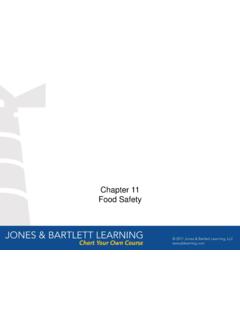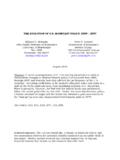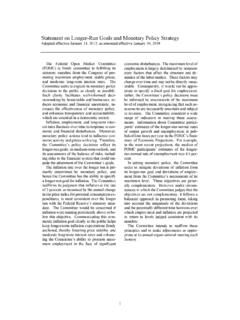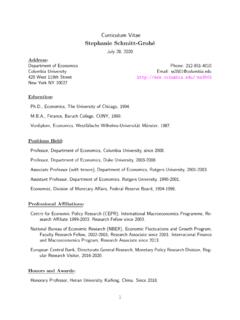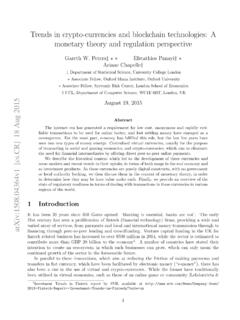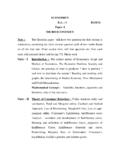Transcription of American Economic Association
1 American Economic AssociationThe Role of monetary PolicyAuthor(s): Milton FriedmanReviewed work(s):Source: The American Economic Review, Vol. 58, No. 1 (Mar., 1968), pp. 1-17 Published by: American Economic AssociationStable URL: .Accessed: 05/02/2013 18:22 Your use of the JSTOR archive indicates your acceptance of the Terms & Conditions of Use, available at ..JSTOR is a not-for-profit service that helps scholars, researchers, and students discover, use, and build upon a wide range ofcontent in a trusted digital archive. We use information technology and tools to increase productivity and facilitate new formsof scholarship. For more information about JSTOR, please contact . American Economic Association is collaborating with JSTOR to digitize, preserve and extend access to TheAmerican Economic This content downloaded on Tue, 5 Feb 2013 18:22:41 PMAll use subject to JSTOR Terms and ConditionsU This content downloaded on Tue, 5 Feb 2013 18:22:41 PMAll use subject to JSTOR Terms and ConditionsNumber 69 of a series of photographs of past presidents of the Association .
2 This content downloaded on Tue, 5 Feb 2013 18:22:41 PMAll use subject to JSTOR Terms and ConditionsThe American Economic Review Volume LVIII MARCH 1968 Number 1 THE ROLE OF monetary POLICY* By MILTON FRIEDMAN** There is wide agreement about the major goals of Economic policy: high employment, stable prices, and rapid growth. There is less agree- ment that these goals are mutually compatible or, among those who re- gard them as incompatible, about the terms at which they can and should be substituted for one another. There is least agreement about the role that various instruments of policy can and should play in achieving the several goals. My topic for tonight is the role of one such instrument- monetary policy. What can it contribute? And how should it be conducted to con- tribute the most? Opinion on these questions has fluctuated widely. In the first flush of enthusiasm about the newly created Federal Reserve System, many observers attributed the relative stability of the 1920s to the System's capacity for fine tuning-to apply an apt modern term.
3 It came to be widely believed that a new era had arrived in which busi- ness cycles had been rendered obsolete by advances in monetary tech- nology. This opinion was shared by economist and layman alike, though, of course, there were some dissonant voices. The Great Con- traction destroyed this naive attitude. Opinion swung to the other ex- treme. monetary policy was a string. You could pull on it to stop infla- tion but you could not push on it to halt recession. You could lead a horse to water but you could not make him drink. Such theory by aphorism was soon replaced by Keynes' rigorous and sophisticated analysis. Keynes offered simultaneously an explanation for the presumed im- potence of monetary policy to stem the depression, a nonmonetary in- terpretation of the depression, and an alternative to monetary policy * Presidential address delivered at the Eightieth Annual Meeting of the American Eco- nomic Association , Washington, , December 29, 1967.
4 ** I am indebted for helpful criticisms of earlier drafts to Armen Alchian, Gary Becker, Martin Bronfenbrenner, Arthur F. Burns, Phillip Cagan, David D. Friedman, Lawrence Harris, Harry G. Johnson, Homer Jones, Jerry Jordan, David Meiselman, Allan H. Meltzer, Theodore W. Schultz, Anna J. Schwartz, Herbert Stein, George J. Stigler, and James Tobin. This content downloaded on Tue, 5 Feb 2013 18:22:41 PMAll use subject to JSTOR Terms and Conditions2 THE American Economic REVIEW for meeting the depression and his offering was avidly accepted. If li- quidity preference is absolute or nearly so-as Keynes believed likely in times of heavy unemployment-interest rates cannot be lowered by monetary measures. If investment and consumption are little affected by interest rates-as Hansen and many of Keynes' other American dis- ciples came to believe-lower interest rates, even if they could be achieved, would do little good.
5 monetary policy is twice damned. The contraction, set in train, on this view, by a collapse of investment or by a shortage of investment opportunities or by stubborn thriftiness, could not, it was argued, have been stopped by monetary measures. But there was available an alternative-fiscal policy. Government spending could make up for insufficient private investment. Tax reductions could un- dermine stubborn thriftiness. The wide acceptance of these views in the economics profession meant that for some two decades monetary policy was believed by all but a few reactionary souls to have been rendered obsolete by new eco- nomic knowledge. Money did not matter. Its only role was the minor one of keeping interest rates low, in order to hold down interest pay- ments in the government budget, contribute to the "euthanasia of the rentier," and maybe, stimulate investment a bit to assist government spending in maintaining a high level of aggregate demand.
6 These views produced a widespread adoption of cheap money poli- cies after the war. And they received a rude shock when these policies failed in country after country, when central bank after central bank was forced to give up the pretense that it could indefinitely keep "the" rate of interest at a low level. In this country, the public denouement came with the Federal Reserve-Treasury Accord in 1951, although the policy of pegging government bond prices was not formally abandoned until 1953. Inflation, stimulated by cheap money policies, not the widely heralded postwar depression, turned out to be the order of the day. The result was the beginning of a revival of belief in the potency of monetary policy. This revival was strongly fostered among economists by the theoreti- cal developments initiated by Haberler but named for Pigou that pointed out a channel-namely, changes in wealth-whereby changes in the real quantity of money can affect aggregate demand even if they do not alter interest rates.
7 These theoretical developments did not un- dermine Keynes' argument against the potency of orthodox monetary measures when liquidity preference is absolute since under such cir- cumstances the usual monetary operations involve simply substituting money for other assets without changing total wealth. But they did show how changes in the quantity of money produced in other ways could affect total spending even under such circumstances. And, more This content downloaded on Tue, 5 Feb 2013 18:22:41 PMAll use subject to JSTOR Terms and ConditionsFRIEDMAN: monetary POLICY 3 fundamentally, they did undermine Keynes' key theoretical proposi- tion, namely, that even in a world of flexible prices, a position of equi- librium at full employment might not exist. Henceforth, unemployment had again to be explained by rigidities or imperfections, not as the nat- ural outcome of a fully operative market process. The revival of belief in the potency of monetary policy was fostered also by a re-evaluation of the role money played from 1929 to 1933.
8 Keynes and most other economists of the time believed that the Great Contraction in the United States occurred despite aggressive expansion- ary policies by the monetary authorities-that they did their best but their best was not good enough.' Recent studies have demonstrated that the facts are precisely the reverse: the monetary authorities followed highly deflationary policies. The quantity of money in the United States fell by one-third in the course of the contraction. And it fell not because there were no willing borrowers-not because the horse would not drink. It fell because the Federal Reserve System forced or permitted a sharp reduction in the monetary base, because it failed to exercise the responsibilities assigned to it in the Federal Reserve Act to provide liquidity to the banking system. The Great Contraction is tragic testimony to the power of monetary policy-not, as Keynes and so many of his contemporaries believed, evidence of its impotence.
9 In the United States the revival of belief in the potency of monetary policy was strengthened also by increasing disillusionment with fiscal policy, not so much with its potential to affect aggregate demand as with the practical and political feasibility of so using it. Expenditures turned out to respond sluggishly and with long lags to attempts to ad- just them to the course of Economic activity, so emphasis shifted to taxes. But here political factors entered with a vengeance to prevent prompt adjustment to presumed need, as has been so graphically illus- trated in the months since I wrote the first draft of this talk. "Fine tun- ing" is a marvelously evocative phrase in this electronic age, but it has little resemblance to what is possible in practice-not, I might add, an unmixed evil. It is hard to realize how radical has been the change in professional opinion on the role of money. Hardly an economist today accepts views that were the common coin some two decades ago.
10 Let me cite a f ew examples. In a talk published in 1945, E. A. Goldenweiser, then Director of the Research Division of the Federal Reserve Board, described the pri- mary objective of monetary policy as being to "maintain the value of Government This country" he wrote, "will have to adjust to 'In [2], I have argued that Henry Simons shared this view with Keynes, and that it accounts for the policy changes that he recommended. This content downloaded on Tue, 5 Feb 2013 18:22:41 PMAll use subject to JSTOR Terms and Conditions4 THE American Economic REVIEW a 212 per cent interest rate as the return on safe, long-time money, be- cause the time has come when returns on pioneering capital can no longer be unlimited as they were in the past" [4, p. 1 17]. In a book on Financing A merican Prosperity, edited by Paul Homan and Fritz Machlup and published in 1945, Alvin Hansen devotes nine pages of text to the "savings-investment problem" without finding any need to use the words "interest rate" or any close facsimile thereto [5, pp.]


